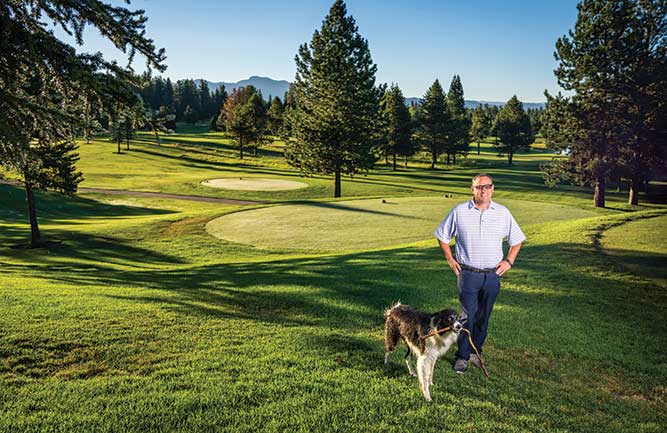Ultra-smart, ultra-meticulous & ultra-driven: Jared Nemitz’s journey to the top
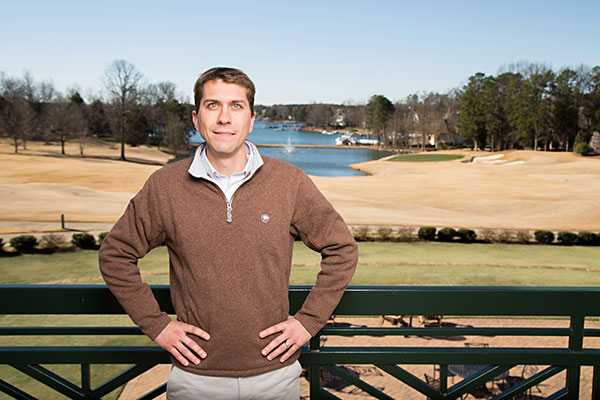
Jared Nemitz of The Peninsula Club takes charge of his greens, and his career, with a military-like precision, (Photo: Peter Taylor)
The 10th hole at The Peninsula Club, Cornelius, N.C., is a 565-yard par 5 from the tips. That’s common knowledge, right on the scorecard.
What’s not common knowledge is that this green, conveniently located near the maintenance facility, had 345 pounds of grass cut from it in 2015. It had 18,765 pounds of sand applied to it. It was mowed 250 times, rolled 135 times, verticut 43 times and covered 33 times. Its average hight of cut was .130, its average Stimp reading was 11.3.
It’s not important to The Peninsula Club’s members that the crew takes these meticulous measurements daily. These numbers mean absolutely nothing to the common golfer.
It is important to them that this Champion ultradwarf bermudagrass green, like its 18 siblings on the property, is the smoothest and truest it has ever been.
The superintendent behind this success is Jared Nemitz, winner of Golfdom’s 2016 Herb Graffis Businessperson of the Year award. In only 10 years, the Purdue graduate (Bachelor of Science, 2006; Master of Science, 2009) has gone from analytics-driven bentgrass grower to one of the nation’s leading experts on ultradwarf bermudagrass.
How has he done it? With hard work and dedication… by listening and learning… by combining a green thumb with a vivid understanding of science and thorough documentation.
But when it comes to impressing golfers, hard work and numbers don’t speak for themselves — it takes an appreciation for business and results to bring it all together.
Hungry intern
While it might not feel like it to Nemitz, he’s come from humble beginnings to the top of the profession in a short time.
Only 33 years old, Nemitz’s career path prior to The Peninsula Club includes premiere courses with legendary superintendents like Chevy Chase Club, Washington, D.C., where Dean Graves is CGCS; Honors Course, Ooltewah, Tenn., where David Stone is superintendent; and Ford Plantation, Savannah, Ga., where Nelson Caron presides.
Not bad for a Tennessee kid who can remember living in a rented attic with his mom, dad and brother, or the college student who made rent donating plasma twice a week.
“I got $30 for the first visit, if you came back that same week you got a $50 bonus,” Nemitz recalls. “That $80 a week paid rent every month. But it also made drinking really cheap — my blood was so thin, one beer and I was toast.”
It was at the Honors Course where Nemitz met his mentor and friend, Nelson Caron, now the superintendent at Ford Plantation. Caron could tell early on that the new intern was cut from a different cloth.
“He has this understanding of turfgrass that others wish they had,” Caron says. “And he was one of the hungriest interns I’ve ever had. He was one of those interns you had to ask to go home.”
The Admiral of Ultradwarf didn’t abide by typical college kid rules, it seems.
“We knew we had someone special when all the kids went to spring break, and most of them went to Panama Beach,” Caron recalls. “Jared came back to the Honors Course and we rebuilt the third green — 12 days of hard labor.”
Life-changing call
Caron was hired in 2008 as superintendent at Ford Plantation, and called on his friend and colleague Nemitz to join him at the course.
He had a mission for Nemitz. He wanted him to use his master’s degree and all the fancy Excel spreadsheets he’s known for to scientifically prove that Ford Plantation should switch from ultradwarf bermudagrass to bentgrass. At the time, Nemitz had been a bentgrass/Poa guy his entire career. He was happy to accept the challenge.
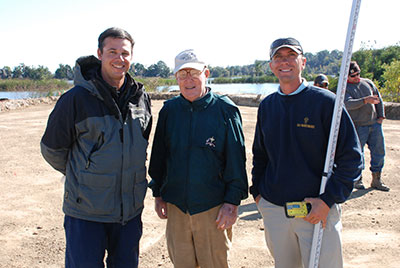
Nelson Caron, Pete Dye and Jared Nemitz, pictured during their time together at Ford Plantation. (Photo: Jared Nemitz)
This was before either of the two met with Rodney Lingle, CGCS, then superintendent at Memphis CC.
“I remember Nelson calling me from the Memphis airport, and he said, ‘Jared, your life is about to change forever,’” Nemitz recalls.
The cause of Caron’s call was a visit to the USGA’s Ultradwarf Bermudagrass Workshop, hosted by Lingle. Caron remembers the workshop, and that phone call, “like it was yesterday.”
“I had an incredible experience, it ended up being a life-changer for me and my staff,” Caron says. “I’ve been to all the best clubs in the world, I mean that. When I set foot on those greens at Memphis CC, they were the best I’d ever seen. It dawned on our team: We had the same resources as Memphis CC, we were just as smart, and now we had a road map. I called Jared and said, ‘Stop everything you’re doing.’”
Caron taught Nemitz what he could, then sent him to see Lingle himself. Nemitz was equally impressed.
“Lingle is the Godfather — he paved the way for ultradwarfs,” Nemitz says. “He was busting down doors with ultradwarfs when people were just making fun of him, saying they’d never take off.”
Lingle is now superintendent at Escondido Lake & Golf Club in Horseshoe Bay, Texas. Despite the hundreds of turf pros he schooled over the years of hosting the event, Lingle says both Nemitz and Caron stood out, and probably have surpassed him.
“I told those guys I’ll be greatly disappointed if in 10, 15 years from now, when I’m retired, if you haven’t taken what I’ve done and blown it out of the water,” Lingle says. “Jared is so good, he’s one of two guys in the world that if I needed someone to help me with my greens to save my life, he’d be one of the two I’d call.” (The other superintendent? Josh Cook, Oak Tree National Golf Club, Edmond, Okla.)
Live, eat, breathe agronomy
Caron and Nemitz implemented Lingle’s program at Ford Plantation to great success. Caron was promoted to a director, and Nemitz took his position as superintendent.
But Nemitz had a goal to be a superintendent on his own by age 30, and time was running out. Enter The Peninsula Club, a Rees Jones design built 25 years ago that, like more than 500 courses, had converted its greens to Champion ultradwarf. COO Ray Armini, CCM, was seeking an “up-and-coming star” to manage the new putting surfaces to peak potential.
“I was very focused on finding someone who was familiar with Champion bermudagrass,” Armini recalls. “But we picked Jared because of his passion — you can tell he lives, eats and breathes agronomy and grass.”
Armini says the 2016 Graffis Award winner is one of the best hires he’s ever made. For Nemitz, now a father of two (Ainsley, 3, and Gavin, 5 months), he calls the hiring “a weight off my shoulders.”
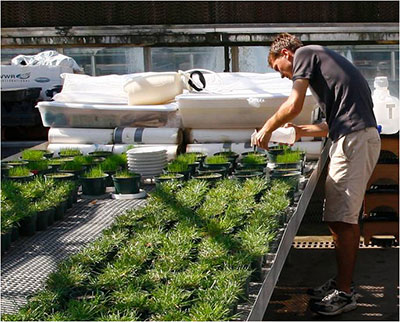
“(My master’s degree) taught me how to present all this massive data and condense it for people who don’t understand the industry very well,” Nemitz says. (Photo: Jared Nemitz)
“I applied for 30 jobs… if you don’t know someone, the résumé doesn’t get you an interview,” Nemitz says. “I got the job at 29, two months later I turned 30. That goes back to setting goals — it’s amazing how goals happen when you set them.”
Nemitz was primarily hired to improve The Peninsula Club’s greens. He quickly learned that he was also brought on to help create a master plan to improve the entire course.
“On my first week of the job, I was meeting with Greg Muirhead (of Rees Jones Design) to go around and start master planning,” Nemitz says. “Muirhead had to drive the cart, I didn’t know where to go. Greg is driving me around saying, ‘OK, this is No. 1….’”
No pressure
The next year, Lingle was changing jobs, and the Ultradwarf Bermudagrass Workshop was looking for a new home course. The USGA’s Patrick O’Brien, agronomist for the Southeast Region, knew where he wanted it to go: The Peninsula Club, despite Nemitz being in only his second season.
“He was implementing all these practices, and it was working to perfection,” O’Brien says. “His greens are always in spectacular condition.”
“I never felt like I was worthy,” Nemitz says. “I was still learning how the grass reacts. When 50 superintendents come in, and none of them are younger than me… it was intimidating because I respect all those superintendents, and I didn’t want to mess up.”
Nemitz and his crew stepped up to the task, and the meeting has found a new home. The event returns to The Peninsula Club on June 27th. O’Brien also asked Nemitz to write an article for the USGA’s Best Management Practices case study website.
“Jared is definitely deserving of this award,” O’Brien says. “He’s one of the smartest agronomists I’ve met in my time with the USGA.”
Excel excellence
Nemitz clearly knows his ultradwarfs, but it was his dedication to detailed record keeping that first caught the attention of Golfdom (sharp-eyed readers will recognize Nemitz from the magazine’s July 2015 19th Hole interview, where he happily called himself a “turf nerd.”)
Excel spreadsheets are seemingly Nemitz’s hobby. He’s a meticulous record keeper, charting measurements daily, like the clipping yields from No. 10 green.
O’Brien says that while Nemitz’s practice of charting something such as clippings yield isn’t unheard of, the detail in his work stands alone.
“The record keeping that he has done is very precise, and it’s good metrics to have as a superintendent,” O’Brien says. “I think he’s the type of new modern agronomist that really fits into this industry well.”
The best thing about this data, Nemitz says, is he can translate it for the member.
“(Members) all do some type of business, 100 percent of them,” Nemitz says. “If I start throwing around soil pHs, they are going to ask me what the heck I’m talking about… but when I can equate data to a bottom-line dollar, that’s what they appreciate. Show them where the money is going — it’s results-based planning.”
Lingle remembers looking at Nemitz’s spreadsheets and being equally impressed and dismayed.
“He showed me a very detailed log when he was at Ford Plantation, and I asked him, ‘When do you have time to do anything else?’” Lingle laughs. “He’s good at it and can do it quickly… more power to him — I can’t work that fast.”
So how does Nemitz find the time? Easy… he doesn’t do it anymore.
“I put it on my team,” Nemitz says. “My tracking of things is very little today. I give it to (the assistants) because I want them to learn. I want my guys to learn why we make decisions, and they’re a part of those decisions. I believe I was mentored very well, I want to make sure I’m a good mentor to them.”
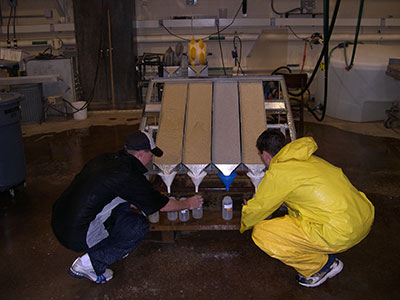
On being a superintendent, Nemitz says, “There’s a business side, a science side, and a green thumb. Those three things I’m always trying to combine. It’s a lot of fun.” (Photo: Jared Nemitz)
First Assistant Superintendent Nick McLennan, who met Nemitz at Ford Plantation, admits that all the Excel spreadsheets were a lot to take in at first, but now it’s second nature. McLennan is tasked with charting Stimp readings, height of cut, greens applications, topdressing amounts and daily observations on greens conditions. An example entry from Dec. 27th, 2014: “Greens look great and still have abundant moisture. Many full leaf blades visible.” The green was Stimping at 11.6 with a .175 height of cut.
“When it’s a daily assignment, it doesn’t take that much time. It only takes two minutes,” McLennan says. “This is what makes me happy, learning how to manage.”
While Nemitz enjoys having the detailed reports, he stresses that data isn’t everything.
“You can’t get away from the green thumb. I don’t care what any number says, if it looks bad it looks bad,” he says. “I take the green thumb and combine it with science and put it in a business person’s language. That gets us ahead.”
Big goals
Nemitz wasn’t always destined for a career in turf. He once talked to a recruiter for the Marines. A World War II history buff, Nemitz is a fan of legendary WWI and WWII veteran Admiral Chester Nimitz. He thought the military lifestyle might be right for him.
But he also loved working on the crew at Bent Oak CC in Elkhart, Ind. When the superintendent there suggested he look into turfgrass as a career — he had not considered it until then — he soon found himself enrolled at Purdue.
His turf life has taken him around the world. He studied at the University of Aberystwyth in Wales; he worked on the crew at St. Andrews during the 2005 Open Championship; he was a speaker at the European Turfgrass Society meeting in Pisa, Italy.
“I never would have thought in a million years that a little kid weed-eating to 9 p.m. at night could go to the Golfdom Summit, or speak across the country,” Nemitz says. “It’s amazing where the industry is going, the professionalism, and how guys are developed. I’m pretty proud to be a part of it, and I’m proud of where we’re going.”
Nemitz credits hard work and his mentors for his success. He mentions his dad, Randy Nemitz, who taught him his work ethic. Randy worked a variety of jobs before becoming a pastor. Nemitz knows how hard his father worked to get his family out of that rented attic.
Nemitz and his crew have their sites set firmly on their next goals of the master plan. Stabilizing the lake banks, an updated pump system and then a bunker renovation are all on the horizon.
For Nemitz personally, he has a bigger goal: He wants to be the next Dean Graves of the industry, an admirable goal.
“I have a great wife, a great general manager, a great club, great assistants,” Nemitz says. “When you have all these things, you have harmony. You’re blessed. Right now, all these things are coming together, and it’s showing.”
Photo courtesy of Jared Nemitz, by Peter Taylor Mclennan










